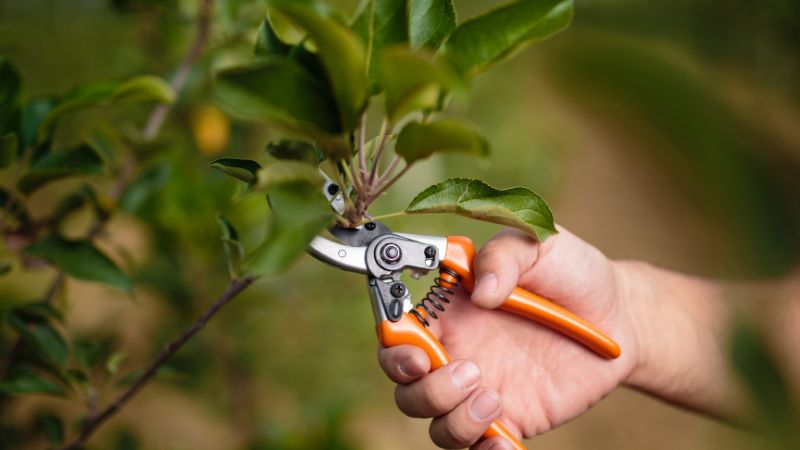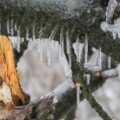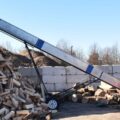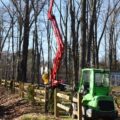Powdery mildew is a silent enemy in eastern Pennsylvania that often goes unnoticed until it’s too late. This common fungal disease poses a significant threat to the health and appearance of our trees and shrubs, as well as landscape plants. The white to gray fuzzy spots or blotches of powdery mildew appear on leaves, destroying the appeal of your landscape and weakening or even killing plants. This uninvited guest thrives in eastern PA’s climate, affecting a wide range of woody ornamentals and trees.
In this article, we delve into the complexities of powdery mildew, including:
- how to identify powdery mildew,
- when and where it’s most likely to appear,
- prevention tips to keep this fungal disease at bay, and
- treatment options to help infected trees and shrubs recover.
Understanding Powdery Mildew: Symptoms and Signs to Look Out For
Powdery mildew is a common fungal disease that affects a wide range of trees and shrubs. It appears as a white powdery substance on the leaves, stems, and flowers of plants, giving them an unhealthy and unsightly appearance.
This disease is caused by various fungi, including Podosphaera and Erysiphe, and is usually more prevalent in areas with high humidity and poor air circulation.
One of the first signs of powdery mildew on trees and shrubs is the appearance of white or grayish powdery patches on the leaves. These patches may start small and gradually spread across the entire leaf surface, inhibiting the plant’s ability to photosynthesize and obtain vital nutrients. As the infestation progresses, the affected leaves may become distorted, twisted, or discolored, further compromising the overall health of the plant.
In addition to the leaves, powdery mildew can also affect the stems, flowers, and even fruits of trees and shrubs. Infected stems may show signs of stunted growth or dieback, while flowers may fail to open properly or develop abnormally. Fruits, such as apples or grapes, may have a powdery appearance, leading to reduced quality and yield.
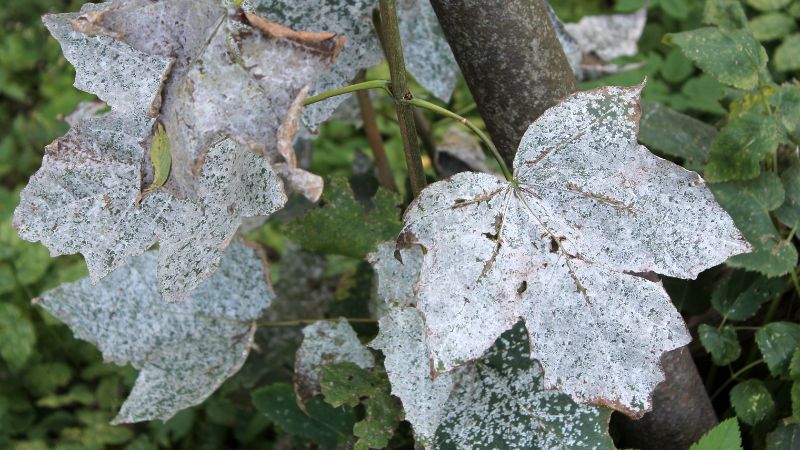
Environmental Factors Contributing to Powdery Mildew Infestations
Although you cannot control all environmental factors that lead to the development of powdery mildew, it’s important to understand what exacerbates the disease and what actions you can take to mitigate it.
Humidity and Moisture
One of the primary environmental factors that favor the development of powdery mildew on trees and shrubs is humidity. High humidity levels create an ideal breeding ground for the fungus, as it thrives in moist conditions.
Temperature
Another contributing factor is temperature. Powdery mildew tends to thrive in moderate temperatures ranging from 60 to 80 degrees Fahrenheit. These optimal conditions facilitate the germination and growth of the fungus, leading to infestations.
Fluctuations in temperatures, especially during spring and fall, can also weaken the plants’ defenses and make them more susceptible to infection.
Lack of Air & Sunlight
Overcrowding and limited sunlight can also contribute to powdery mildew infestations. When trees and shrubs are planted too closely together, they create a microclimate that traps moisture and restricts air movement, allowing the spores to settle and spread easily. Insufficient sunlight hinders the plants’ ability to dry out, providing an ideal environment for the fungus to proliferate.
Preventive Measures to Safeguard Your Trees and Shrubs Against Powdery Mildew
There are several preventive measures you can take to safeguard your trees and shrubs against powdery mildew.
Ensure Adequate Air Circulation
Make sure to provide adequate air circulation by spacing out your plants and trimming away any overcrowded foliage. Prune dead or infected branches to reduce the risk of disease spread. Regularly inspect your trees and shrubs for any signs of powdery mildew and promptly remove any infected plant material to prevent further contamination.
Water Correctly
Another important preventive measure is watering your plants correctly. Powdery mildew thrives in humid conditions, so avoid overhead watering and instead water at the base of the plants. Watering early in the day allows foliage to dry quickly, reducing the chances of powdery mildew development. Additionally, try not to overwater, as excessive moisture can create an ideal environment for fungal growth.
Keep Soil Healthy
Maintaining a healthy soil environment is vital in preventing powdery mildew. Apply a layer of organic mulch around the base of your trees and shrubs to retain moisture and regulate soil temperature.
Regularly fertilize your plants with balanced nutrients to ensure their overall health and natural resistance to diseases. Be careful to avoid over-fertilization, as it can promote excessive new growth that is more susceptible to powdery mildew.
By maintaining good plant care practices, watering correctly, and ensuring a healthy soil environment, you can create unfavorable conditions that limit the growth and spread of this fungal disease.
Best Practices for Treating Powdery Mildew on Trees and Shrubs
Powdery mildew can be a persistent and frustrating problem. If you have confirmed that your plants are infected with powdery mildew, it’s important to take immediate action to effectively treat the disease and prevent its spread.
This can include removing and disposing of severely infected plant parts, applying fungicides, or using natural alternatives like neem oil or baking soda sprays.
Natural Treatment Options
There are several natural remedies available, although they work best for smaller shrubs and plants, rather than trees.
Neem oil, for example, is a popular choice due to its antifungal properties. Mix a few tablespoons of neem oil with water and spray it onto the infected plants, paying close attention to both the top and bottom of the leaves.
Another effective remedy is a mixture of baking soda and water, which can help control the fungus. Spray this solution onto the plants every one to two weeks until the powdery mildew disappears.
Integrated Pest Management Strategies for Long-Term Powdery Mildew Control
Integrated pest management (IPM) strategies offer a comprehensive approach to controlling powdery mildew on trees and shrubs. By combining cultural, biological, and chemical control methods, you can achieve long-term management of this fungal disease to maintain the health and visual appeal of your plants while also protecting the environment.
Biological Controls for Powdery Mildew
Biological controls can play a significant role in managing powdery mildew. This involves introducing or enhancing beneficial organisms that naturally attack the fungus. For instance, certain predatory fungi can compete with powdery mildew, preventing its spread. Ladybugs and lacewings are also effective predators of aphids, which can contribute to the development of powdery mildew. Encouraging biodiversity and creating a hospitable environment for these beneficial organisms can help control the disease.
Chemical Treatments
When cultural and biological control methods alone are not sufficient, judicious use of chemical controls may be necessary. Selecting appropriate fungicides is crucial to ensure effectiveness while minimizing harm to beneficial organisms and the environment. Always read and follow label instructions carefully, applying fungicides in accordance with recommended rates and timing.
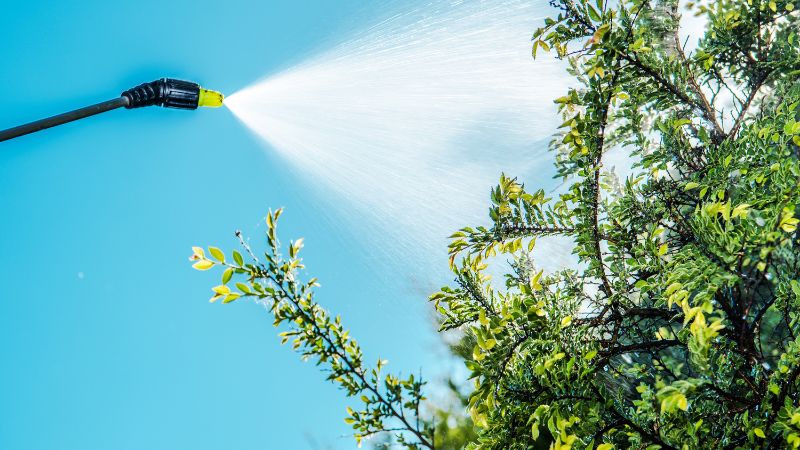
When to Seek Professional Help for Severe Powdery Mildew Cases
While mild cases of powdery mildew can often be managed with DIY methods such as pruning affected leaves or applying homemade remedies, severe cases may require the expertise of a professional. Recognizing when to seek professional help is crucial to prevent further damage and ensure the health and longevity of your plants.
Extensive & Persistent Infection
One of the main indicators that it’s time to consult with an expert is when the powdery mildew outbreak is extensive and persistent despite your best efforts. If the powdery white patches continue to spread and cover a significant portion of the affected plants, it may be a sign that the disease has reached a critical stage. Tree care professionals have in-depth knowledge and experience in dealing with severe powdery mildew cases, enabling them to identify the specific type of fungus causing the outbreak and recommend appropriate treatments.
High Value Plants are Infected
Another critical factor to consider is the type and value of the plants affected by powdery mildew. If you have valuable or rare tree and shrub species in your garden, it’s wise to consult with a professional immediately to ensure the best chances of recovery. Experts can provide customized solutions tailored to the specific needs of your plants, including the use of targeted fungicides or advanced treatment techniques that may not be readily available to the average gardener.
Treatment Has Been Ineffective
Finally, if you have tried multiple DIY methods to no avail or lack the necessary time and resources to manage the problem effectively, seeking professional help is a practical choice. Experts possess the necessary tools, equipment, and expertise to tackle severe powdery mildew outbreaks efficiently. Their specialized knowledge of integrated pest management approaches ensures a holistic treatment strategy that considers both short-term control and long-term prevention.
Tired of Battling Powdery Mildew? Call Clauser Tree Care for Effective Control
While mild cases of powdery mildew on trees and shrubs can often be handled independently, severe outbreaks warrant consulting with professionals such as the arborists at Clauser Tree Care. Our expertise, experience, and access to specialized resources can make a significant difference in managing the disease and protecting the health of your plants. Don’t hesitate to call us at 215-542-8291 when confronted with stubborn and extensive powdery mildew cases to ensure the best outcome for your garden.

About Clauser Tree Care
From who you talk to on the phone in our office, to our courteous and experienced work crews who provide your service, all of the hard-working team members at Clauser Tree Care strive for complete client satisfaction. Our job is simply not done until you are pleased with the experience that you have had working with our company. Founded more than 25 years ago on the principles of honest work and arboricultural best practices, we strive for a higher standard of care for a greener future.


